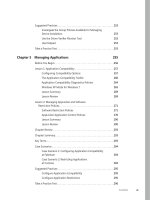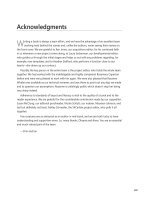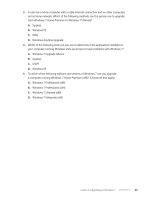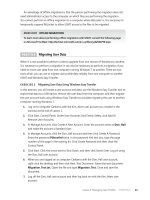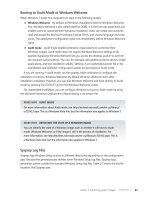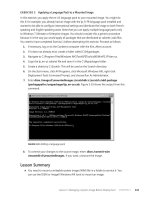Configuring Windows 7 (Training Kit) - Part 62 doc
Bạn đang xem bản rút gọn của tài liệu. Xem và tải ngay bản đầy đủ của tài liệu tại đây (342.37 KB, 10 trang )
Lesson 2: Windows 7 Mobility CHAPTER 11 583
Windows 7 allows you to configure basic and advanced settings for each plan. The settings
that you can configure depend on your computer’s hardware configuration. The Edit Plan
Settings dialog box, shown in Figure 11-27, allows you to configure a plan’s basic settings.
Some computers do not support the Dim The Display or Adjust Plan Brightness settings.
When you configure the basic settings of a plan, you configure different values for when
the computer is plugged in or when the computer is running on internal battery power. On
desktop computers that do not use an internal battery, it is possible to configure only the
Plugged In settings.
FIGURE 11-27 Configure basic plan settings
A user who has an account that is not a member of the local Administrators group is able
to modify what the power and sleep buttons do. If they are able to elevate privileges, they
can also specify whether a password is required when the computer wakes from the sleep
state. You can configure these options by clicking Choose What The Power Buttons Do, which
opens the Power Options System Settings dialog box, shown in Figure 11-28. The options that
you can configure are Sleep, Hibernate, Shut Down, and Do Nothing.
Windows 7 supports the following sleep, shutdown, and hibernation modes:
n
Sleep When Windows 7 is in the Sleep state, the processor and the majority of
system devices are in a turned-off state. The computer’s RAM remains in a turned-
on state so that it can maintain the user’s open applications and documents. Devices
that are configured to wake the computer from sleep, such as USB mice, keyboards,
and network cards, remain in a turned-on state. If the computer is not woken after
a configurable amount of time, the computer transitions to the Hibernate state. You
can wake a computer from sleep by using the keyboard or mouse.
5 8 4 CHAPTER 11 BitLocker and Mobility Options
FIGURE 11-28 Configure power buttons
n
Hybrid Sleep Hybrid Sleep is a power-saving feature that is used with desktop
computers that do not have a battery-based power backup. If a desktop computer
is in Sleep mode and suffers an interruption to its power supply, data loss may occur.
The contents of the computer’s RAM are stored both in the RAM in a low-power
state and as a special file on the hard disk. When the Hybrid Sleep option is enabled,
computers put to sleep use Hybrid Sleep rather than ordinary Sleep mode.
n
Hibernate When Windows 7 is in the Hibernate state, all devices are turned off
and the contents of the computer’s RAM are stored in a special file on the operating
system volume. All devices are in a turned-off state. You can turn on a computer that is
hibernating only by using the power buttons.
n
Shutdown In the Shutdown state, the contents of RAM are not preserved. All devices
are in a turned-off state.
More Info Windows 7 POWER MANAGEMENT
For more information about the new power management features available in Windows 7,
including Wake On LAN, consult the following Microsoft TechNet article: http://technet
.microsoft.com/en-us/library/dd744300(WS.10).aspx.
Lesson 2: Windows 7 Mobility CHAPTER 11 585
Advanced Power Plan Settings
To configure the advanced power plan settings, click the Change Advanced Power Settings
item in the Edit Plan Settings dialog box. Unlike the basic plan settings, which a user who
is not a member of the local administrators group can modify, only a user with elevated
privileges can modify advanced power plan settings. The advanced plan settings are shown in
Figure 11-29.
FIGURE 11-29 Advanced power settings
Using the Advanced Settings dialog box in Power Options, you can configure the following
settings for both the On Battery and Plugged In states:
n
Require A Password On Wakeup Specifies whether a password is required after the
computer resumes from hibernation or sleep.
n
Turn Off Hard Disk Specifies the period of inactivity after which to turn off the hard
disk drive.
n
Desktop Background Settings Specifies whether animated desktop backgrounds,
such as the slideshow background, are available when the computer is on battery or
plugged in.
•
Wireless Adapter Settings Configure the power performance of the wireless
adapter. Possible settings are Maximum Performance, Low Power Saving, Medium
Power Saving, and Maximum Power Saving. Different settings influence the
performance of the adapter, reducing the adapter’s maximum range and speed.
5 8 6 CHAPTER 11 BitLocker and Mobility Options
n
Sleep This setting allows you to configure the Sleep and Hibernation periods for
a computer. You learned about the difference between Sleep, Hybrid Sleep, and
Hibernate earlier in this lesson. The options are the following:
•
Sleep After Specifies the period of inactivity after which the computer is put into
sleep mode
•
Allow Hybrid Sleep Specifies whether the computer can use Hybrid Sleep
•
Hibernate After Specifies the period of sleep after which the computer goes into
hibernation
•
Allow Wake Timers Specifies whether timed events should be allowed to wake the
computer from sleep
n
USB Settings Specifies whether selective suspend is enabled for USB.
n
Power Buttons And Lid Specifies what happens to the computer when you close
a laptop computer’s lid, when you press the power button, and when you press the
sleep button. Options include Do Nothing, Sleep, Hibernate, and Shut Down.
n
PCI Express Specifies whether Windows 7 can utilize the PCI Express Link State Power
Management feature with idle devices. This can be configured to Moderate Power
Savings, Maximum Power Savings, or Off.
n
Processor Power Management Specifies a minimum processor state and a maximum
processor state in terms of percentage. It is also possible to specify whether the system
cooling policy is active.
n
Display Specifies the period after which to dim the display and the period after
which to turn off the display. It is also possible to specify the display brightness during
normal use and the display brightness when set to the dim setting.
n
Multimedia Settings This section contains the following policies:
•
When Sharing Media Configure the computer’s response when a remote
computer is accessing media over the network. Options include allowing the
computer to sleep, prevent idling to sleep, and allowing the computer to enter
Away mode.
•
Video Playback Settings Options include optimizing video quality, balanced and
optimize power savings.
n
Battery Specifies the Reserve, Low, and Critical battery levels as a percentage. It is
also possible to specify what action that the computer should take when the battery
reaches the Low and Critical levels. Actions include Do Nothing, Sleep, Hibernate, and
Shut Down.
If the three power plans may not meet your specific needs, it is possible to create a custom
power plan. To create a custom plan, click Create A Power Plan in the Power Options control
panel. You can delete a custom power plan so long as the plan that you want to delete is not
currently active. You cannot delete any of the default power plans. You will create a custom
power plan in the practice exercise at the end of this lesson.
Lesson 2: Windows 7 Mobility CHAPTER 11 587
Power-Related Group Policies
Group Policy settings related to Power Management are located in the Computer
Configuration\ Administrative Templates\System\Power Management node. This node
contains five nodes, as shown in Figure 11-30.
FIGURE 11-30 Power-related Group Policies
You can configure all the settings that you learned about in the section entitled “Advanced
Power Plan Settings,” earlier in this chapter, through these policies. There are several
additional settings, located in the Sleep Settings node, that you can configure only through
Group Policy. These settings are as follows:
n
Allow Applications To Prevent Automatic Sleep
n
Allow Automatic Sleep With Open Network Files
n
Turn On The Ability For Applications To Prevent Sleep Transition
Each of these policies relates to whether applications or open network files can prevent
a computer from entering the Sleep state automatically. When these policies are disabled,
only direct user input is taken into account when determining whether the computer should
enter the Sleep state. These policies have no impact when a user puts the computer into the
Sleep state manually.
Command-line Power Configuration
Powercfg.exe is a command-line utility that you can use from an administrative command
prompt to manage Windows 7 power settings. It is possible to use Powercfg.exe to configure
a number of Windows 7 power-related settings that you cannot configure through Group
Policy or the Advanced Plan Settings dialog box. You can use Powercfg.exe to configure
specific devices so that they are able to wake the computer from the Sleep state. You can
also use Powercfg.exe to migrate power policies from one computer running Windows 7 to
another by using the import and export functionality. Table 11-2 contains a list of some of the
Powercfg.exe options and the tasks that they can be used to accomplish.
5 8 8 CHAPTER 11 BitLocker and Mobility Options
TABLE 11-2 Powercfg.exe Options
COMMAND OPTION FUNCTION
-list Lists all the current power schemes.
-query <scheme_guid> Displays the contents of the specified power
scheme.
-change Use this to change a specific setting in the current
power scheme.
-hibernate Use this to enable or disable the Hibernate feature.
-devicequery <option> Lists devices that can wake the computer, as
follows:
n
Wake_From_Any Lists all devices that
support waking the computer from any Sleep
state.
n
Wake_Armed Lists all devices currently
configured to wake the computer from any
Sleep state.
-deviceenablewake <devicename> Enables the device to wake the computer from
Sleep state.
-devicedisablewake <devicename> Disables the device from waking the computer
from Sleep state.
-import / -export Allows you to migrate a power policy by import
and exporting power plans.
-lastwake Provides information on what event last triggered
the computer to wake from sleep.
-requests List application and driver power requests that
may prevent a computer from entering Sleep
mode.
-requestsoverride Allows you to override a particular application or
driver power request to stop it from blocking the
computer from entering Sleep mode.
-energy Check the computer for common energy-efficiency
and battery life problems. Provides report in
Hypertext Markup Language (HTML) format.
More Info Powercfg.exe
For more information on Powercfg.exe, consult the following Microsoft TechNet
document: /> Lesson 2: Windows 7 Mobility CHAPTER 11 589
eXaM tIP
Remember what command-line command to use to determine which hardware devices can
wake a client running Windows 7 from sleep.
Practice Managing Power Plans
Custom power plans allow you to configure power management settings that best suit the
individual needs of your organization. In this practice, you explore the process of creating
a custom power plan and then simulate migrating that plan to other computers running
Windows 7.
exercise 1 Creating a Custom Power Plan
In this exercise, you create a custom power plan based on the Power Saver power plan and
configure advanced plan settings.
1. Log onto computer Canberra using the Kim_Akers user account.
2. In the Search Programs And Files text box, type Power Options. Click the Power
Options item to open the Power Options control panel.
3. Select the Power Saver plan and then click Create A Power Plan.
4. On the Create A Power Plan page, select the Power Saver plan and then enter the
custom name Extreme Power Saver, as shown in Figure 11-31, and click Next.
FIGURE 11-31 New custom power plan
5. On the Change Settings For the Plan: Extreme Power Saver page, click Create. In the
Power Options control panel, click Change Plan Settings. On the Edit Plan Settings
dialog box, click Change Advanced Power Settings.
5 9 0 CHAPTER 11 BitLocker and Mobility Options
6. In the Power Options Advanced Settings dialog box, shown in Figure 11-32, click
Change Settings That Are Currently Unavailable.
FIGURE 11-32 Power Options Advanced Settings dialog box
7. Change the Require A Password On Wake Up setting to No.
8. Expand the Power Buttons And Lid node. Set the Sleep Button action to Hibernate.
9. Expand the Processor Power Management node. Set the Maximum Processor State to
80%. Click OK. Close the Edit Plan Settings dialog box.
exercise 2 Migrating a Power Plan
In this exercise, you use the Powercfg.exe command-line utility to export the plan that you
created in Exercise 1. You then delete the plan you created and import it as a substitute for
importing the plan on another computer.
1. At an elevated command prompt, type powercfg.exe –list. This should provide
output similar to that shown in Figure 11-33, though the power scheme globally
unique identifiers (GUIDs) will be different. Take a note of the GUID assigned to the
Extreme Power Saver plan. You may want to use the command prompt ability to mark
and copy data to copy the GUID to memory because you will need this identifier in
step 4.
2. Create the directory C:\Export if it does not already exist. Change into this directory.
3. Issue the command powercfg.exe –energy. When the command finishes executing,
issue the command start energy-report.html. This opens Windows Internet Explorer
with the report, as shown in Figure 11-34. Review the report and then close the
Internet Explorer window.
Lesson 2: Windows 7 Mobility CHAPTER 11 591
FIGURE 11-33 List of plans and GUIDs
FIGURE 11-34 Energy Report
4. Issue the command powercfg.exe –export extreme.pow {GUID}, where {GUID} is
the GUID of the Extreme Power Saver plan.
5. Issue the command powercfg.exe –setactive SCHEME_BALANCED.
6. Verify that the Balanced power scheme is set by issuing the command powercfg.exe
–list. Make a note of the GUID assigned to the Extreme Power Saver plan.
7. Enter the command powercfg.exe –delete {GUID}, where {GUID} is the GUID of the
Extreme Power Saver plan.
5 9 2 CHAPTER 11 BitLocker and Mobility Options
8. Verify that the Extreme Power Saver plan has been deleted by issuing the command
powercfg.exe –list. You should see only three power schemes, as shown in Figure 11-35.
FIGURE 11-35 Verifying deletion of the power plan
9. Issue the command powercfg.exe –import c:\export\extreme.pow.
10. Verify that the power scheme has been imported successfully by issuing the command
powercfg.exe –list. You should see that the Extreme Power Saver plan is now
available.
Lesson Summary
n
Offline Files is a feature of Windows 7 Professional, Enterprise, and Ultimate editions
that allows a user to manipulate a file that is hosted on a shared folder when he is not
connected to the network that hosts the shared folder.
n
Offline Files creates a cached copy of the file on the local computer that is synchronized
automatically with the file server whenever connectivity to the file server is established.
n
Sync Center can be used to perform a manual synchronization of offline files. Sync
Center can also be used to resolve synchronization conflicts that occur when an offline
file and a shared file are modified during the same period.
n
Transparent caching provides automatic caching of files on shared folders that are on
remote networks. Transparently cached files are available only to the local computer
and are not synchronized as offline files are.
n
Power Plans control how a computer running Windows 7 uses energy. Normal users
can select a power plan to meet their needs without having to elevate privileges.
n
The default Windows 7 Power Plan is Balanced. Other plans that ship with Windows 7
include Power Saver and High Performance.
n
Powercfg.exe can be used to import and export power policies, allowing you to
migrate them between computers.

